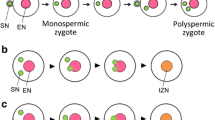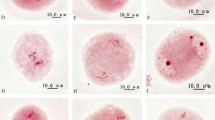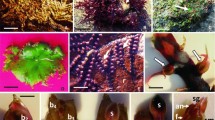Abstract
Extensive cytological studies into all stages of pollinial development in 10 diploid species of orchids belonging to the Arethuseae tribe revealed four possible mechanisms operating premeiotically and meiotically, resulting in the formation of polyploid spores in the form of monads, dyads and triads. The mechanisms involved are: (1) premeiotic disturbances resulting in tetraploid pollen mother cells; (2) faulty anaphase disjunction giving rise to restitution nuclei at both meiotic divisions; (3) failure to participate in meiosis I or meiosis II; and (4) co-orientation of the two spindles during metaphase II. Why fertile diploid species should possess elaborate pathways for the formation of such spores cannot be explained satisfactorily in view of the low frequencies of such spores formed and the absence of a euploid series in the four genera investigated. Nevertheless, these orchid genera, with high basic numbers, could be highly evolved polyploids and the regular formation of such spores could be viewed as a relic of their evolutionary past.
Similar content being viewed by others
References
Arends J. C., 1970. Cytological observations on genome homology in eight interspecific hybrids of Phalaenopsis. Genetica 41: 88–100.
Bradley M. V., 1948. A method for making aceto-carmine squashes permanent without removal of the cover-slip. Stain Technol. 23: 41–44.
Brandham P. E., 1982. Inter-embryo competition in the progeny of autotriploid Aloineae (Liliaceae). Genetica 59: 29–42.
Hagerup O., 1938. Studies on the significance of polyploidy. II. Orchis. Hereditas 24: 258–264.
Hagerup O., 1947. The spontaenous formation of haploid, polyploid and aneuploid embryos in some orchids. K. danske Vidensk. Selsk. Biol. Meddr. 20: 1–22.
Harmsen L., 1943. Studies on the cytology of arctic plants. II. Habenaria. Meddr. Grønland. 131: 1–15.
Häglund M., 1970. Meiosis in Solanum phureja. Hereditas 66: 183–188.
Holttum R. E., 1964. Flora of Malaya. Vol. 1. Orchids. 3rd Ed. Government Printing Office, Singapore.
Humphrey L. M., 1934. The somatic chromosomes of Cypripedium hirsutum and six species of the genus Habenaria. Am. Nat. 68: 184–186.
Jones K. & Daker M. G., 1968. The chromosomes of orchids, III. Catasetinae Schltr. Kew Bull. 22: 421–427.
Kamemoto H., 1950. Polyploidy in Cattleya. Am. Orchid Soc. Bull. 19: 366–373.
Kamemoto H., 1958. Polyploidy in Vanda. Proc. Second World Orchid Conf., Harvard Univ. Press, Cambridge, Mass. pp. 51–55.
Kamemoto H., Meeyot W. & Takeshita M., 1972. Breeding behaviour of polyploid Dendrobium orchids. J. Am. Soc. Hort. Sci. 97: 3–5.
Kamemoto H., Sagarik R. & Kasemsap S., 1964b. Chromosome numbers of Sarcanthine orchid species of Thailand. Nat. Hist. Bull. Siam Soc. 20: 235–241.
Kamemoto H. & Shindo K., 1962. Genome relationships in interspecific and intergeneric hybrids of Renanthera. Am. J. Bot. 49: 737–748.
Kamemoto H., Shindo K. & Kosaki K., 1964a. Chromosome homology in the Ceratobium, Phalaenanthe, and Latourea Sections of the genus Dendrobium. Pacif. Sc. 18: 104–115.
Kamemoto H. & Tara M., 1969. The relationship of Renanthera storiei and Trichoglottis fasciata. Brittonia 21: 126–129.
Kliphuis E., 1963. Cytological observations in relation to the taxonomy of the orchids of the Netherlands. Acta bot. neerl. 12: 172–194.
Lam S. L., 1974. Origin and formation of unreduced gametes in the potato. J. Hered. 65: 175–178.
Levan A., 1941. Syncyte formation in the pollen mother cells of haploid Phleum pratense. Hereditas 27: 243–252.
Matsuura H., 1935. A cytological study of Phacellanthus tubiflorus Siels. et Zucc. I. J. Fac. Sci. Hokkaido Imp. Univ. 3: 169–187.
Mehlquist G. A. L., 1947. Polyploidy in the genus Paphopedilum Pfitz. (Cypripedium Hort.) and its practical implications. Miss. bot. Gard. Bull. 35: 211–228.
Miduno T., 1940. Chromosomenstudien an Orchidazeen. III. Über das Vorkommen von haploiden Pflanzen bei Bletilla striata. Reichb. f. var. gebina Reichb. f. Cytologia 11: 156–177.
Rhoades M. M. & Dempsey E., 1966. Induction of chromosome doubling at meiosis by the elongate gene in maize. Genetics 54: 505–522.
Satina S. & Blakeslee A. F., 1935. Cytological effects of a gene in Datura which causes dyad formation in sporogenesis. Bot. Gaz. 96: 521–532.
Snow R., 1963. Alcoholic hydrochloric acid-carmine as a stain for chromosomes in squash preparations Stain Technol. 38: 9–13.
Stern H., 1946. The formation of polynucleated pollen mother cells. J. Hered. 37: 47–50.
Storey W. B., 1952. Chromosome numbers in some Vanda species and hybrids. Am. Orchid Soc. Bull. 21: 801–806.
Storey W. B., 1956. Diploid and polyploid gamete formation in orchids. Am. Soc. hort. Sci. 68: 491–502.
Storey W. B., Kamemoto H. & Shindo K., 1963. Chromosomes of Vanda spathulata and its hybrids. Am. Orchid Soc. Bull. 32: 703–709.
Tanaka R., 1965. Intraspecific polyploidy in Goodyera maximowicziana Makino. Kromosomo 60: 1945–1950.
Tanaka R. & Kamemoto H., 1960. Meiotic chromosome behaviour in diploid and polyploid Vanda orchid hybrids. Cytologia 25: 405–418.
Tanaka R. & Kamemoto H., 1961. Meiotic chromosome behaviour in some intergeneric hybrids of the Vanda alliance. Am. J. Bot. 48: 573–582.
Tanaka R., Karasawa K. & Ishida G., 1981. Karyomorphological observations on Calanthe of Japan. Bull. Hiroshima bot. Gard. 4: 9–62.
Teoh S. B., 1980. Cytological studies in Malayan members of the Phaius tribe (Orchidaceae). II. Meiotic and B-chromosomes. Caryologia 33: 483–493.
Teoh S. B., 1982. ‘Complement Fractionation’ in natural diploid orchid species. Theor. appl. Genet. 61: 91–95.
Teoh S. B. & Lim S. N., 1978. Cytological studies in Malayan members of the Phaius tribe (Orchidaceae). I. Somatic chromosomes. Malaysian J.Sci. 5(A): 1–11.
Author information
Authors and Affiliations
Rights and permissions
About this article
Cite this article
Teoh, S.B. Polyploid spore formation in diploid orchid species. Genetica 63, 53–59 (1984). https://doi.org/10.1007/BF00137465
Received:
Accepted:
Issue Date:
DOI: https://doi.org/10.1007/BF00137465




